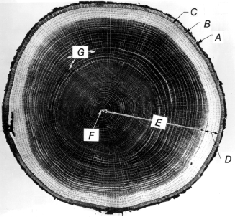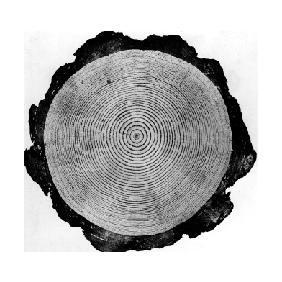B. Bark, Wood, Branches, and Cambium
A cross section of a tree (Fig. 2–1) shows the following well defined features (from outside to center): bark, which may be divided into an outer corky dead part (A), whose thickness varies greatly with species and age of trees, and an inner thin living part (B), which carries food from the leaves to growing parts of the tree; wood, which in merchantable trees of most species is clearly differentiated into sapwood (D) and heartwood (E); and pith (F), a small core of tissue located at the center of tree stems, branches, and twigs about which initial wood growth takes place. Sapwood contains both living and dead tissue and carries sap from the roots to the leaves. Heartwood is formed by a gradual change in the sapwood and is inactive. The wood rays (G), horizontally oriented tissue through the radial plane of the tree, vary in size from one cell wide and a few cells high to more than 15 cells wide and several centimeters high.
The rays connect various layers from pith to bark for storage and transfer of food. The cambium layer (C), which is inside the inner bark and forms wood and bark cells, can be seen only with a microscope. As the tree grows in height, branching is initiated by lateral bud development. The lateral branches are intergrown with the wood of the trunk as long as they are alive. After a branch dies, the trunk continues to increase in diameter and surrounds that portion of the branch projecting from the trunk when the branch died. If the dead branches drop from the tree, the dead stubs become overgrown and clear wood is formed.
Most growth in thickness of bark and wood is caused by cell division in the cambium (Fig. 2–1C). No growth in diameter takes place in wood outside the cambial zone; new growth is purely the addition and growth of new cells, not the further development of old ones. New wood cells are formed on the inside of the cambium and new bark cells on the outside. Thus, new wood is laid down to the outside of old wood and the diameter of the woody trunk increases. In most species, the existing bark is pushed outward by the formation of new bark, and the outer bark layers become stretched, cracked, and ridged and are finally sloughed off.
Fig. 2-1

Fig. 2-2
